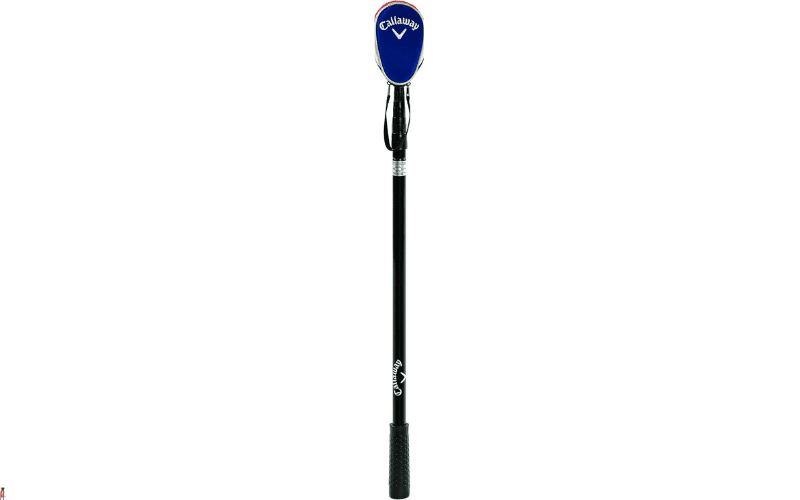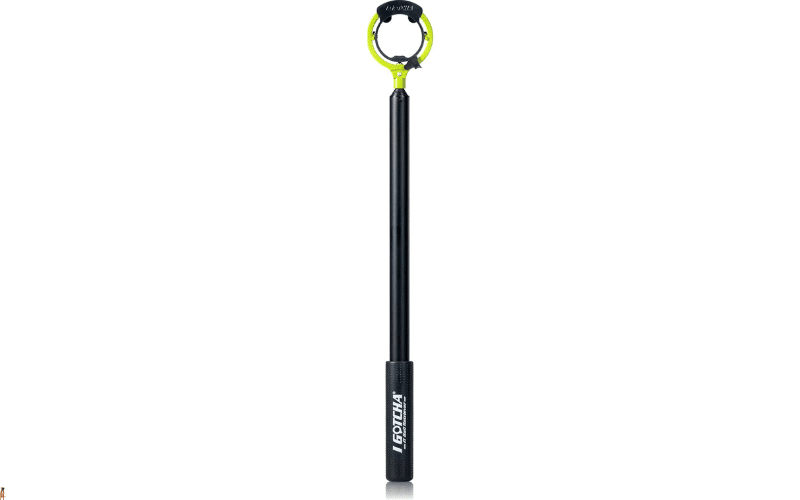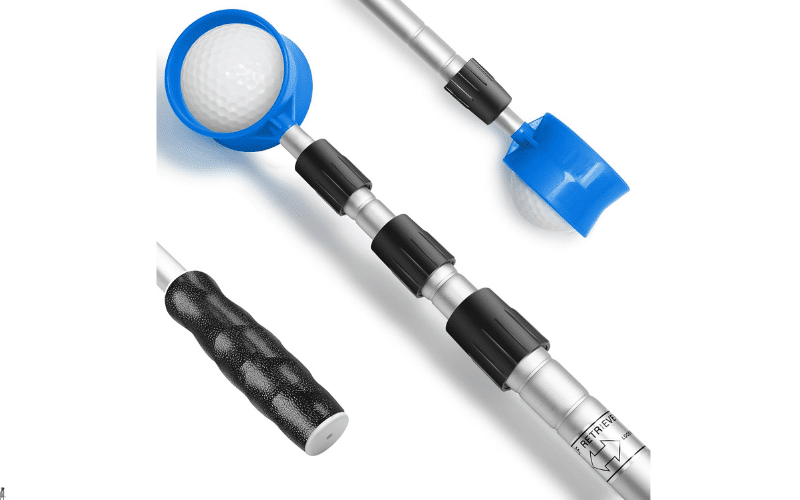Key Takeaways
- Choose a golf ball retriever that extends 6 to 18 feet, depending on your typical playing conditions.
- Durability is key; look for retrievers made from aluminum or stainless steel for long-lasting use.
- Compact models fit easily in your golf bag, enhancing portability without adding bulk.
- A good retriever should securely grip the ball, minimizing retrieval time and effort.
- Consider your playing environment and frequency of use to find the best retriever for your needs.
Choosing the Right Golf Ball Retriever for Your Golfing Needs
Golfing is a game of precision, patience, and sometimes, a little bit of luck. But what happens when your ball veers off course, landing in a pond or a dense patch of rough? That's where a golf ball retriever becomes your best friend. Investing in the right one can save you time, money, and frustration.
Most importantly, the right golf ball retriever ensures you spend more time playing and less time searching. But with so many options available, how do you choose the perfect one? Let’s explore the key aspects to consider when selecting a golf ball retriever that suits your specific needs.
Reasons to Invest in a Golf Ball Retriever
Investing in a golf ball retriever is a smart move for any golfer. It helps you recover lost balls from tricky spots, saving you money on replacements. Besides that, it reduces the time spent searching for balls, allowing you to focus more on improving your game. It’s also an environmentally friendly choice, as it encourages the reuse of balls instead of constant buying.
Understanding Different Types of Retrievers
There are several types of golf ball retrievers available, each designed to meet specific needs. Let's break down the main types:
- Telescopic Retrievers: These are adjustable and can extend to various lengths, making them versatile for different situations.
- Scoop Retrievers: These use a scooping mechanism to pick up balls, ideal for water hazards.
- Spring-Loaded Retrievers: These secure the ball with a spring mechanism, ensuring a firm grip.
Each type has its advantages and disadvantages. Telescopic retrievers, for instance, offer great reach but can be cumbersome. Scoop retrievers are excellent for water but might struggle in dense grass. Spring-loaded ones are reliable but might be pricier. Therefore, understanding your specific needs and playing environment is crucial. For a comprehensive guide, check out the best golf ball retrievers.
Factors to Consider
Choosing the right golf ball retriever involves more than just picking the first one you see. There are several factors to consider, each playing a critical role in ensuring you get the most out of your purchase.
Length and Reach
The length of your retriever determines how far you can reach to recover your ball. Standard retrievers range from 6 to 18 feet. If you frequently play on courses with water hazards or dense trees, a longer retriever is beneficial. However, if you mostly play on open courses, a shorter, more compact retriever might suffice.
Durability and Materials
Durability is non-negotiable. A robust retriever withstands frequent use and rough conditions. Look for models made from materials like aluminum or stainless steel, which offer excellent durability and corrosion resistance. A durable retriever not only lasts longer but also performs reliably, ensuring you can count on it when you need it most.
Besides the material, consider the construction quality. Check for sturdy joints and a reliable locking mechanism, especially in telescopic models. A well-built retriever provides a smoother experience and minimizes the risk of malfunction during use.
Ball Security Mechanism
One of the most important features of a golf ball retriever is how well it secures the ball. A reliable ball security mechanism ensures that once you've retrieved the ball, it stays in place until you release it. This is crucial for efficiency, especially when retrieving from tricky spots like water hazards.
Retrievers often use a locking mechanism or a scoop to secure the ball. Locking mechanisms, such as spring-loaded traps, are highly effective in keeping the ball from slipping away. On the other hand, scoop mechanisms might require more precision during retrieval but offer simplicity in design. Choose a mechanism that aligns with your comfort and skill level.
Top Picks for Golf Ball Retrievers
With so many options on the market, it can be challenging to know which golf ball retriever is right for you. Below, I've highlighted some of the top picks that stand out due to their features, durability, and user satisfaction.
Callaway Golf Ball Retriever

The Callaway Golf Ball Retriever is renowned for its robust design and ease of use. Made with high-quality aluminum, it offers durability without being overly heavy. Its telescopic design allows it to extend up to 15 feet, making it ideal for retrieving balls from water hazards or dense roughs. The ergonomic handle ensures a comfortable grip, reducing fatigue during extended use.
Gotcha Ultimate XL Ball Retriever

The Gotcha Ultimate XL Ball Retriever is another excellent choice, especially for those who prioritize reach. This model extends up to 18 feet, giving it one of the longest reaches available. Its patented head design ensures a secure grip on the ball, minimizing the chance of dropping it during retrieval. The lightweight construction makes it easy to carry in your golf bag.
- Length: Extends up to 18 feet
- Material: Lightweight yet durable aluminum
- Special Feature: Patented head design for secure ball grip
Overall, the Gotcha Ultimate XL is perfect for golfers who often find themselves in challenging situations on the course. Its superior reach and secure grip make it a reliable companion. For more options, check out the best golf ball retrievers.
Prowithlin Golf Ball Retriever

The Prowithlin Golf Ball Retriever combines affordability with functionality. It features a simple yet effective design, with a telescopic pole that extends up to 12 feet. The retriever is made from rust-resistant stainless steel, ensuring longevity even with frequent exposure to water. Its automatic locking scoop prevents the ball from slipping out, making retrieval quick and efficient.
Maintenance Tips for Longevity
To ensure your golf ball retriever serves you well for many rounds, proper maintenance is essential. Regular care not only prolongs the life of the retriever but also keeps it functioning smoothly.
Here are some maintenance tips to help you get the most out of your retriever:
Cleaning and Storage
After each use, especially in wet or muddy conditions, clean your retriever with a damp cloth to remove dirt and debris. This prevents buildup that can affect performance. For telescopic models, ensure each section is dry before collapsing to avoid moisture getting trapped, which could lead to rust.
When storing your retriever, keep it in a dry place. If possible, store it in a protective case or sleeve to shield it from accidental damage or scratches. Proper storage ensures your retriever is always ready for action when you need it.
Inspecting for Wear and Tear
Regularly inspect your retriever for signs of wear and tear, such as loose joints, bent sections, or worn-out grips. Addressing these issues early can prevent more significant problems down the line. If you notice any damage, consider repairing it or replacing the affected parts. For more tips on maintaining your golf equipment, check out these tips for cleaning and maintaining your gear.
For models with a locking mechanism, ensure it operates smoothly without sticking. Lubricate any moving parts as needed to maintain optimal performance. By keeping a close eye on your retriever's condition, you can enjoy a seamless golfing experience every time.
Personalizing Your Golf Ball Retriever Choice
"Choosing the right golf ball retriever is about matching the tool to your playing style and environment. Consider where you play most often and how frequently you need to retrieve balls."
When selecting a golf ball retriever, think about the conditions you encounter most frequently. If you play on courses with many water hazards, a longer retriever with a secure grip is essential. Conversely, if your primary concern is portability, a compact, lightweight model might be best.
Also, consider how often you play and your budget. Frequent golfers might benefit from investing in a high-end model with advanced features, while occasional players might prefer a more budget-friendly option.
Ultimately, the right golf ball retriever is one that complements your game, meets your specific needs, and enhances your overall golfing experience.
Matching to Your Playing Environment
When selecting a golf ball retriever, it's crucial to consider the environment in which you typically play. If your usual courses feature numerous water hazards, opt for a retriever with a longer reach and a secure grip mechanism. This will help you retrieve balls efficiently from difficult spots without getting too close to the hazard.
Conversely, if you primarily play on dry, open courses, you might prioritize a retriever that is more compact and portable. A shorter, lighter model can be easily carried in your golf bag, ensuring it doesn't become a burden during your round. Matching your retriever to your playing environment maximizes its utility and enhances your overall golfing experience.
Considering Frequency of Use
"The frequency with which you play golf can significantly influence the type of retriever that best suits your needs. Consider how often you find yourself needing to retrieve balls when making your decision, especially when navigating golf course hazards."
If you're a frequent golfer, investing in a high-quality, durable retriever is wise. Such a retriever will withstand regular use and last longer, providing reliable performance each time you need it. Look for models made from robust materials like stainless steel or high-grade aluminum. For more information, check out this guide to choosing the best golf ball retriever.
For those who play less often, a budget-friendly retriever might suffice. While these models may not have all the bells and whistles of premium options, they still offer good value and functionality for occasional use. Consider your playing frequency and budget to find the best retriever for your needs.
Frequently Asked Questions
Choosing the right golf ball retriever can be daunting with so many options available. Here are some frequently asked questions to help guide your decision.
What is the best length for a golf ball retriever?
The best length for a golf ball retriever depends on your specific needs and the environments you encounter. If you often play on courses with water hazards or dense rough, a retriever that extends up to 15-18 feet is beneficial. This length provides ample reach to recover balls from tricky spots.
For golfers who primarily play on open courses, a shorter retriever, around 6-12 feet, might be sufficient. This length offers a good balance between reach and portability, making it easy to carry in your golf bag.
How do I maintain my golf ball retriever?
Maintaining your golf ball retriever is essential for ensuring its longevity and performance. After each use, especially in wet conditions, clean it with a damp cloth to remove dirt and debris. Ensure it's dry before storing it to prevent rust, particularly for telescopic models.
Why choose a more expensive retriever model?
"Investing in a more expensive retriever model often means gaining access to superior materials, extended reach, and advanced features that enhance usability and durability."
Higher-end retrievers often use better materials like stainless steel or premium aluminum, offering increased durability and corrosion resistance. They may also include features such as ergonomic grips, secure locking mechanisms, and longer reach, making them more efficient and reliable.
While they come at a higher price point, these models provide excellent value for frequent golfers who need a tool that can withstand regular use and challenging conditions.
How does a golf ball retriever secure the ball?
Golf ball retrievers secure the ball using various mechanisms, such as spring-loaded traps, scoops, or locking heads. Spring-loaded traps use a tension mechanism to hold the ball firmly, while scoops rely on a cup-like design to capture and hold the ball.
Locking heads often have a mechanism that closes around the ball, ensuring it doesn't slip out during retrieval. Choose a mechanism that you find easy to use and effective for the environments you play in.
Can I carry the retriever in my standard golf bag?
Yes, most golf ball retrievers are designed to be portable and fit within a standard golf bag. Telescopic models are particularly convenient as they can collapse to a compact size, making them easy to store and carry without adding significant weight or bulk.
When choosing a retriever, consider its length when collapsed to ensure it fits comfortably in your bag. A lightweight model will also make it easier to transport, enhancing your overall golfing experience.

